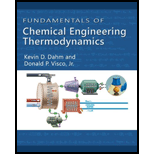
(A)
Interpretation:
The mass flow rate
Concept Introduction:
Write the expression to calculate the mass flow rate
Here, initial velocity of turbine is
(A)
Explanation of Solution
Given information:
Turbine: Pressure of
Inlet velocity is
Pipe diameter is 5 cm.
Refer the Appendix table A-3, “Superheated steam”, obtain the value of specific volume corresponding to pressure of
Calculate the mass flow rate
Substitute
Thus, the mass flow rate
(B)
Interpretation:
The power output
Concept Introduction:
Write the steady state energy balance equation around the turbine.
Here, time taken is
(B)
Explanation of Solution
Given information:
Outlet datum is 1.5 m.
Exhaust steam pressure is 0.9 bar.
Calculate the work output using steady state energy balance equation around the turbine.
Rewrite the steady state Equation (2) by neglecting the heat transfer and work done by expansion or contraction process.
Here, initial specific enthalpy is
Refer the Appendix table A-3, “Superheated steam”, obtain the value of initial specific enthalpy corresponding to pressure of
Refer the Appendix table A-1, “Saturated steam-pressure increments”, obtain the value of final specific enthalpy and specific volume corresponding to pressure of
Calculate the velocity while assuming that the mass flow rate is constant.
Here, initial mass is
Substitute
Substitute
Thus, the power output
(C)
Interpretation:
The efficiency of the turbine
Concept Introduction:
Write the expression to calculate the efficiency of the turbine
Here, rate of actual shaft work is
Write the entropy balance equation around the boiler.
Here, total mass is
(C)
Explanation of Solution
Calculate the reversible entropy using entropy balance equation around the boiler.
Rewrite the Equation (5) by neglecting the surrounding, entropy generation, and reversible entropy term.
Here, initial specific entropy is
Refer the Appendix table A-3, “superheated steam”, write the value of initial specific entropy corresponding to pressure of
As the initial and final specific entropy is same,
Calculate the work output using steady state energy balance equation around the boiler.
Rewrite the steady state Equation (6) by neglecting the heat transfer and work done by expansion or contraction process.
Refer the Appendix table A-3, “Superheated steam”, obtain the value of final specific enthalpy corresponding to pressure of
Substitute
Calculate the efficiency of the turbine
Substitute
Thus, the efficiency of the turbine
Want to see more full solutions like this?
Chapter 4 Solutions
Fundamentals of Chemical Engineering Thermodynamics (MindTap Course List)
 Introduction to Chemical Engineering Thermodynami...Chemical EngineeringISBN:9781259696527Author:J.M. Smith Termodinamica en ingenieria quimica, Hendrick C Van Ness, Michael Abbott, Mark SwihartPublisher:McGraw-Hill Education
Introduction to Chemical Engineering Thermodynami...Chemical EngineeringISBN:9781259696527Author:J.M. Smith Termodinamica en ingenieria quimica, Hendrick C Van Ness, Michael Abbott, Mark SwihartPublisher:McGraw-Hill Education Elementary Principles of Chemical Processes, Bind...Chemical EngineeringISBN:9781118431221Author:Richard M. Felder, Ronald W. Rousseau, Lisa G. BullardPublisher:WILEY
Elementary Principles of Chemical Processes, Bind...Chemical EngineeringISBN:9781118431221Author:Richard M. Felder, Ronald W. Rousseau, Lisa G. BullardPublisher:WILEY Elements of Chemical Reaction Engineering (5th Ed...Chemical EngineeringISBN:9780133887518Author:H. Scott FoglerPublisher:Prentice Hall
Elements of Chemical Reaction Engineering (5th Ed...Chemical EngineeringISBN:9780133887518Author:H. Scott FoglerPublisher:Prentice Hall
 Industrial Plastics: Theory and ApplicationsChemical EngineeringISBN:9781285061238Author:Lokensgard, ErikPublisher:Delmar Cengage Learning
Industrial Plastics: Theory and ApplicationsChemical EngineeringISBN:9781285061238Author:Lokensgard, ErikPublisher:Delmar Cengage Learning Unit Operations of Chemical EngineeringChemical EngineeringISBN:9780072848236Author:Warren McCabe, Julian C. Smith, Peter HarriottPublisher:McGraw-Hill Companies, The
Unit Operations of Chemical EngineeringChemical EngineeringISBN:9780072848236Author:Warren McCabe, Julian C. Smith, Peter HarriottPublisher:McGraw-Hill Companies, The





